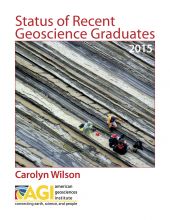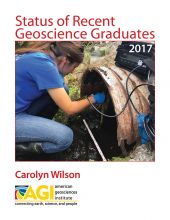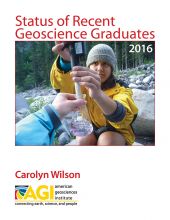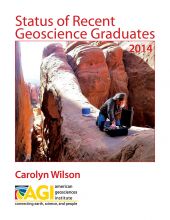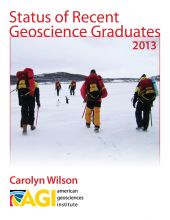The American Geosciences Institute’s (AGI) Status of Recent Geoscience Graduates 2015 provides an overview of the demographics, activities, and experiences of geoscience students that received their bachelor’s, master’s, or doctoral degree during the 2014–2015 academic year. This research draws attention to student preparation in the geosciences and their education and career path decisions, as well as examines many of the questions raised about student transitions into the workforce. The Status of Recent Geoscience Graduates report was first released in 2013 presenting data from spring 2013 graduates. For the 2014 report, the number of participants in the AGI’s Geoscience Student Exit Survey increased by 60% compared to 2013 creating a sample size that better represents the community of geoscience graduates. The 2015 report have participation rates at the approximately the same level as 2014, and many of the trends seen in 2013 and 2014 are echoed in the 2015 report.
This report presents the results for the end user’s consideration. As in previous years, the quantitative skills and knowledge of the graduates have raised concerns about their preparedness for the workforce. In 2015, there was another drop in the percentage of graduates at all degree levels taking Statistics, even though a solid understanding of statistics is necessary for conducting research and reading many articles in peer-reviewed journals. Also, the majority of bachelor’s and master’s graduates complete Calculus II, but there is a strong drop-off in the percentages of these graduates that take higher level quantitative courses, which was also seen in previous years. Discussions with representatives from various industries have indicated that a lack in understanding of high-level math can affect sustained employment or advancement depending on the job expectations.
In 2015, as in previous years, a large percentage of graduates at all degree levels indicated they did not participate in an internship. However, this year the graduates were asked how many internships applications they submitted. Their responses indicated that the graduates understand the importance of internships to their professional develop-ment, but there may not be enough opportunities available to meet the demand for these opportunities.
This year also saw some changes in the future plans of the recent graduates. Fewer graduates indicated a desire to go on to earn a graduate degree in the fall. Many geoscience departments have indicated that they are at capacity for graduate students, and the decrease in students planning to begin work on another degree may be in response to the increased competition for the slots that are available. In regards to the recent graduates entering the geoscience workforce, this was the first year since printing this report that the environmental services industry hired a higher percentage of bachelor’s graduates than the oil and gas industry, indicating this industry as a strong viable option for recent bachelor’s graduates in particular.
AGI is excited about the prospect of continuing this research in the coming years here in the U.S. and inter-nationally. Soon, these reports will look at trends seen in various countries and identify the workforce preparation issues that face the U.S. versus those issues that are of global concern.

